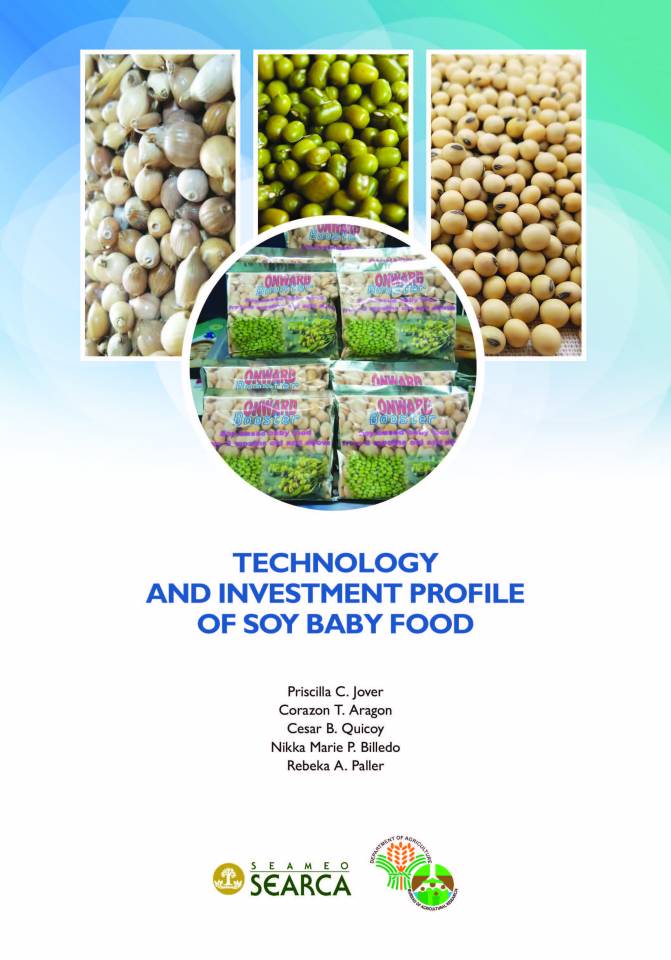A good source of nutrition is crucial in the early stages of a child's life. Having access to nutritious food is essential to their development and there is a variety of baby food in the market. Although in the case of Zamboanga, its manufacturing has suffered losses due to high costs surrounding handling and shipping. This has opened an opportunity for producing baby food products using locally available raw materials in the region.
 This opportunity prompted the development of soy baby food under the Department of Agriculture-Bureau of Agricultural Research (DA-BAR) funded project "Commercialization and Promotion of Organic Soybeans in Region IX." To further disseminate the potential of the product, this has been featured in the published monograph of the Southeast Asian Center for Graduate Study and Research in Agriculture (SEARCA) and DA-BAR titled "Technology and Investment Profile of Soy Baby Food." The monograph is co-authored by Ms. Priscilla Jover, Organic Agriculture focal of DA-Regional Field Office IX, who led the product's development.
This opportunity prompted the development of soy baby food under the Department of Agriculture-Bureau of Agricultural Research (DA-BAR) funded project "Commercialization and Promotion of Organic Soybeans in Region IX." To further disseminate the potential of the product, this has been featured in the published monograph of the Southeast Asian Center for Graduate Study and Research in Agriculture (SEARCA) and DA-BAR titled "Technology and Investment Profile of Soy Baby Food." The monograph is co-authored by Ms. Priscilla Jover, Organic Agriculture focal of DA-Regional Field Office IX, who led the product's development.
In the study, the authors discussed the raw materials of the product. Given the abundance of soybean, adlay, and mungbean along with their many health benefits, these were the identified crops for the soy baby food. In addition, the information campaign done by the DA-BAR project about its health benefits intensified the use of these crops.
Soybean has been a rich source of amino acid necessary for growth and tissue repair. It is also rich in vitamins, a good source of dietary fiber, and contains anti-cancer and anti-inflammatory factors. The crop also helps prevent degenerative diseases, reduces the risk of heart disease, and increases bone density. Like soybeans, adlay is highly nutritious and is believed to aid many ailments, it is known for its antihistaminic, muscle relaxant, and fever-reducing properties. It also strengthens the stomach and spleen, relieve spasms and pain, and helps control bacterial and fungal infections. Similarly, mungbean is one of the best plant-based sources of protein and also rich in amino acids. It contains healthy antioxidants, which may reduce the risk of chronic diseases such as heart disease, diabetes, and certain cancers.
With these raw materials, soy baby food was developed. It is characterized as a protein-rich baby food made from the best organically grown beans like soybean and mungbean blended with adlay cereal. The product is produced through the process of grinding roasted beans, roasting milled adlay, and mixing all said ingredients.
According to the study, soy baby food has a great market potential in Region IX for three reasons. First, it is cheaper compared to existing branded and unbranded baby food products in the market given that the ingredients are abundant and locally sourced. Second, it offers best nutrition for the babies who cannot breastfeed. Lastly, it is a good replacement for baby foods made of dairy products.
According to the authors, when the product was marketed the project staff of DA-RFO IX attended regional and international trade fairs where product samples were displayed and sold. The product is identified to have increasing potential for the market given that parents are now more conscious of the food that they are feeding their babies, hence they are opting for more nutritious baby food.
The observed increasing market potential prompted the development of the "Technology and Investment Profile of Soy Baby Food," which assessed its investment feasibility for interested technology investors. The study discussed the technology and its market potential in more detail. To determine the financial feasibility of the product, the authors used cash flow analysis with the following tools: net present value, benefit-cost ratio, and financial internal rate return. Results showed that the soy baby food have met the parameters for each tool to be identified as a financially viable investment project. The study showed that the soy baby food have promising investment potential given the set assumptions. This indicates that it is a feasible investment that interested investors may look into.
SEARCA is now actively working to support and promote technology-based innovations among local enterprises in the Philippines through its core program on Emerging for Innovation for Growth as outlined in its 11th Five-Year Plan, which is geared towards Accelerating Transformation Through Agricultural Innovation (ATTAIN). The SEARCA-published monograph on technology of soy baby food under the DA-BAR-funded project "Financial Viability and Profitability Analysis of Agricultural Technologies and Enterprises" may be download ed for free from the SEARCA website: https://www.searca.org/pubs/monographs?pid=483